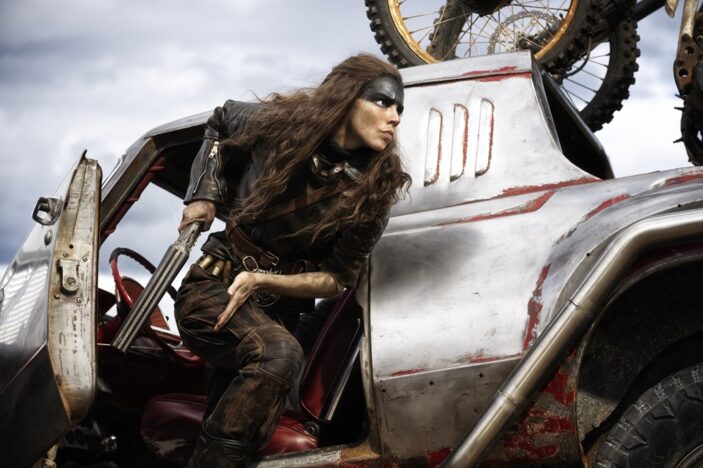
Mad Max: Fury Road felt like a truly once-in-a-lifetime type event upon its release in 2015. It was continuing a series that had laid dormant for 30 years at that point and, despite still relative success both critically and commercially, the third film – 1985’s Beyond Thunderdome – was so often cited as the series’ lowest point. Lead star Mel Gibson wasn’t returning to the fold, mastermind director George Miller was coming off both the cancelled debacle of Justice League and the underperformance of Happy Feet Two, and, as would be revealed over the course of filming, headlining stars Tom Hardy and Charlize Theron did decidedly not get along during filming.
In so many ways the odds were stacked against Fury Road, and yet genius and grit persevered, resulting in a bombastic, exaggerated, emotional action extravaganza that spoke to the unmatched creativity of its director. Critics agreed, audiences adored, and the Academy awarded accordingly. The perfect trifecta.
But that’s Fury Road. What of Furiosa? Or Furiosa: A Mad Max Saga, as it’s officially titled. A prequel about arguably one of the series’ most fascinating characters that spiritually aligns itself within the Mad Max universe as seen through the lens of Fury Road. Theron so magnificently brought the character to life in that film, and, at one point, the Academy Award winner was to star in a variation of this story, but due to certain disputes between the studio and Miller, it never lifted off the ground as expected. A testament to his endurance, Miller’s Furiosa never languished in development for too long, and with Anya Taylor-Joy on hand, the character lives on.
Before she was the buzzcut-adorned, one-armed warrior we know her as in Fury Road, young Furiosa (played initially by Alyla Browne, sharing striking similarities to Taylor-Joy) was raised by a female collective known as the Many Mothers, who had endured the global collapse to create an abundant commune, complete with solar and wind power, plentiful crops and a supply of fresh water. Rightfully so, this haven is kept secret, as to ensure its safety from the scavengers that roam the surrounding wastelands. Said scavengers ultimately kidnap Furiosa from her “place of abundance” and hand her over to Dementus (a prosthetic-nosed Chris Hemsworth, having an absolute ball of a time), a deranged legionnaire who has designs on ruling a trio of supply settlements currently overseen by the equally unhinged Immortan Joe (Lachy Hulme, replacing the late Hugh Keays-Byrne): Gas Town, the Bullet Farm, and The Citadel.
A considerable deal of Furiosa‘s 148 minute running time is dedicated to Dementus and his intention of power, and whilst that could be deemed a criticism due to this being a Furiosa movie, Hemsworth is so captivatingly insane that he avoids all of our complaints. His actions are also crucial to Furiosa’s motivation. She’s out for blood, in this life or the next, and the film takes its time in shaping her towards the fierce symbol she’ll ultimately become in Fury Road. Whilst we know certain tragedy will befall her, and Miller’s script – co-written with Nico Lathouris (Fury Road) – does link the two films together, the world building here is so expansively fascinating that we could forgive if they weren’t so directly tied; a post-Furiosa, pre-Fury Road story seems ripe for the telling.
With the two films so linked, it’s inevitable that they’ll be compared from all views, and the uphill battle Furiosa mainly faces is in its action quota against the sheer kinetic energy of Fury Road. That film was essentially an extended road movie. This structure gave it a certain urgency, and whilst Furiosa is no slouch in the spectacle department – there’s a midway on-the-road sequence that is majestically breath-taking in its execution – the fact that it extends its narrative over however many years leaves it with less punch, but only comparatively. Additionally, whilst it does become a Taylor-Joy vs Hemsworth tale, they’re separated for large chunks of the film, and Furiosa doesn’t have the same kind of dynamic that her Fury Road embodiment was afforded with the stoic Max. Taylor-Joy – who so brilliantly emulates Theron’s speech pattern – is strong-enough of an actress to wear the film on her shoulders, but her relationship with Immortan Joe’s top rig driver, Praetorian Jack (Tom Burke), doesn’t earn as much emotionality as perhaps needed for certain beats of the story to land.
That being said, these prove only minor bumps in the road of an exhilarating actioner from one of the greatest blockbuster filmmakers of our time (if not, all time). The scale of Miller’s imagination is truly awe-inspiring, and, again, the world building on hand feels intimately thoughtful, despite its extended, hellish mentality. The use of VFX may irk certain purists – and, it will be said, the effects use here is felt greater than in Fury Road – but there’s still a dirty humanity felt across the obvious physicality of the surroundings.
Having to follow Fury Road is really the main hinderance of Furiosa‘s existence. That film was such a lighting-in-a-bottle experience, and though this lives within the same template, it manages to find its own identity, thanks in large part to Taylor-Joy and the unbridled Hemsworth. Whilst outside of this universe Miller blesses us with equally fascinating material (I’ll point you towards his most recent Three Thousand Years of Longing), I can’t help but need this Mad world to continue being delved into. Valhalla is so often cited as endgame and, even if it takes close to another decade, audiences deserve that journey.
![]()
![]()
![]()
![]()
![]()
FOUR STARS (OUT OF FIVE)
Furiosa: A Mad Max Saga is screening in Australian theatres from May 23rd, 2024.
